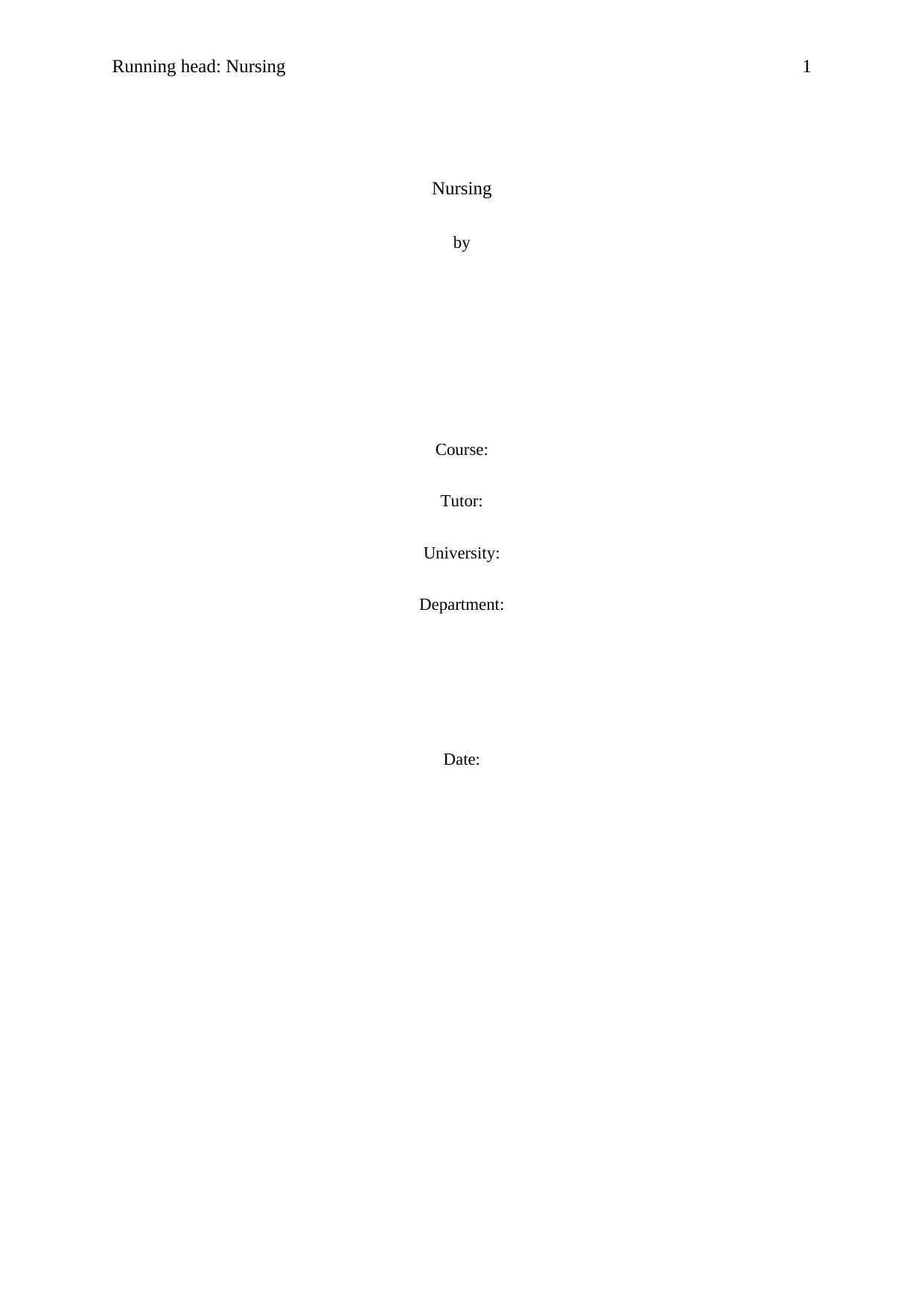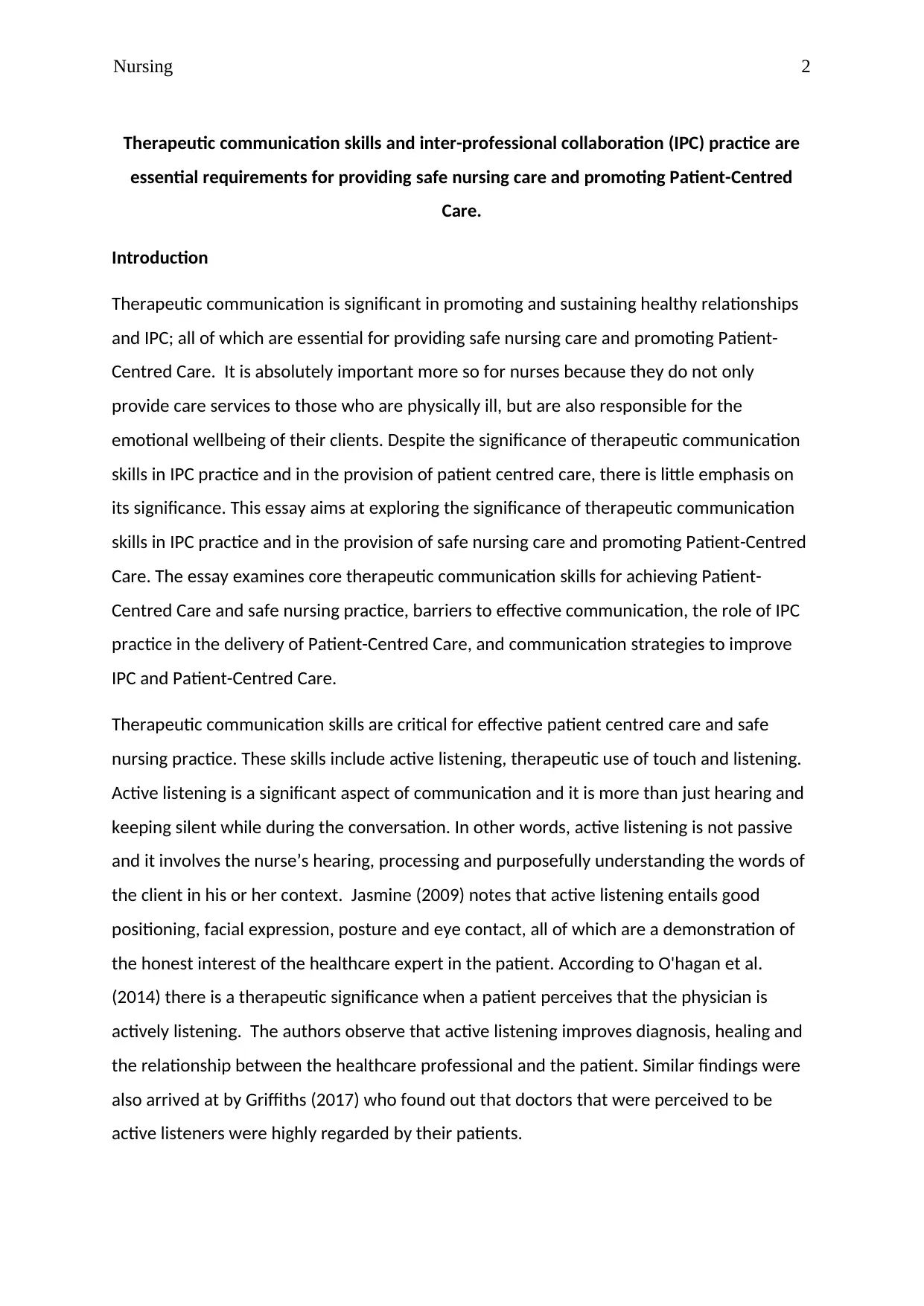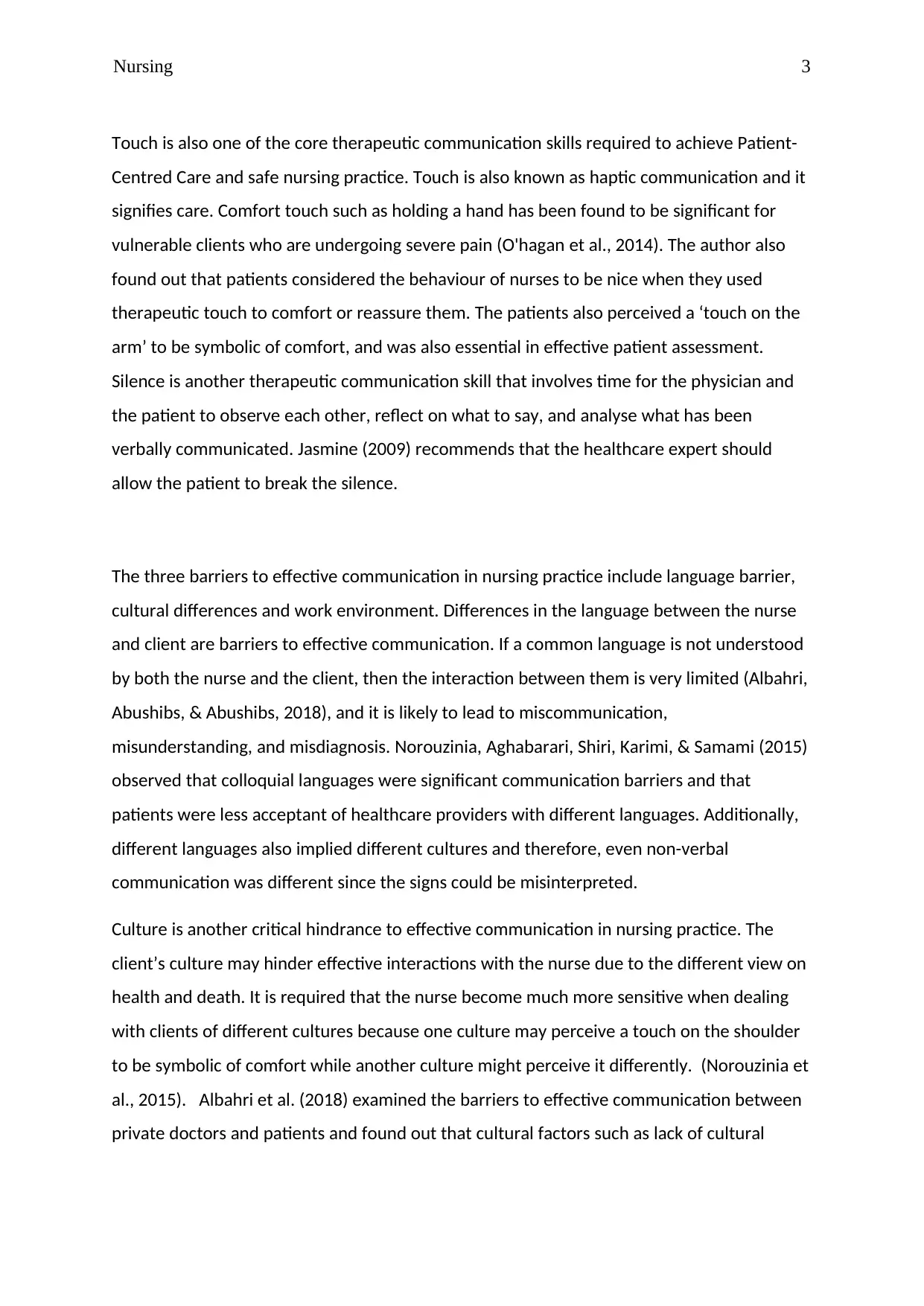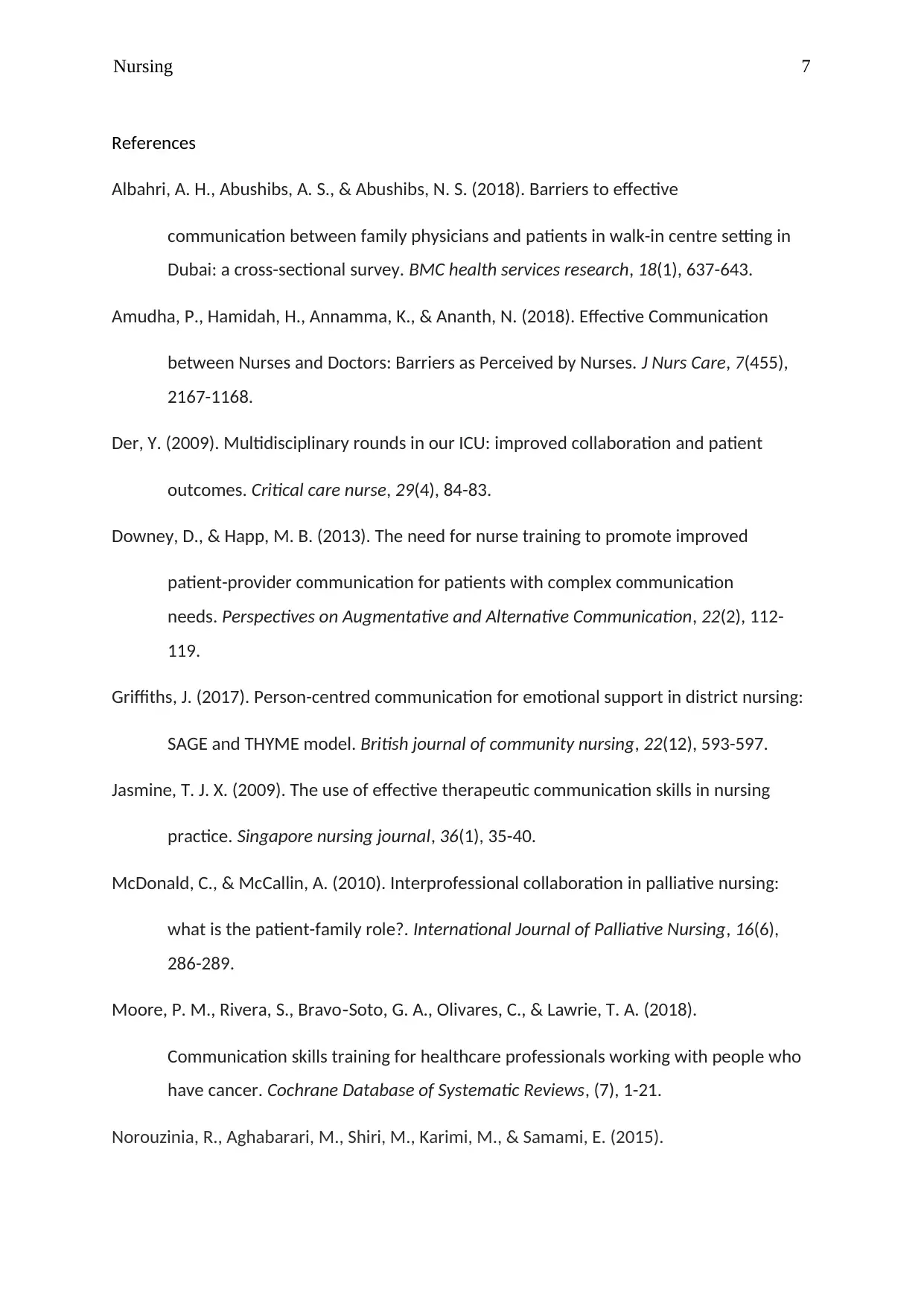Therapeutic Communication Skills and Inter-Professional Collaboration in Nursing
VerifiedAdded on 2023/04/06
|8
|1847
|470
AI Summary
This essay explores the significance of therapeutic communication skills and inter-professional collaboration in nursing for safe patient care and promoting patient-centered care. It discusses core therapeutic communication skills, barriers to effective communication, the role of inter-professional collaboration in patient-centered care, and communication strategies to improve collaboration and patient-centered care.
Contribute Materials
Your contribution can guide someone’s learning journey. Share your
documents today.

Running head: Nursing 1
Nursing
by
Course:
Tutor:
University:
Department:
Date:
Nursing
by
Course:
Tutor:
University:
Department:
Date:
Secure Best Marks with AI Grader
Need help grading? Try our AI Grader for instant feedback on your assignments.

Nursing 2
Therapeutic communication skills and inter-professional collaboration (IPC) practice are
essential requirements for providing safe nursing care and promoting Patient-Centred
Care.
Introduction
Therapeutic communication is significant in promoting and sustaining healthy relationships
and IPC; all of which are essential for providing safe nursing care and promoting Patient-
Centred Care. It is absolutely important more so for nurses because they do not only
provide care services to those who are physically ill, but are also responsible for the
emotional wellbeing of their clients. Despite the significance of therapeutic communication
skills in IPC practice and in the provision of patient centred care, there is little emphasis on
its significance. This essay aims at exploring the significance of therapeutic communication
skills in IPC practice and in the provision of safe nursing care and promoting Patient-Centred
Care. The essay examines core therapeutic communication skills for achieving Patient-
Centred Care and safe nursing practice, barriers to effective communication, the role of IPC
practice in the delivery of Patient-Centred Care, and communication strategies to improve
IPC and Patient-Centred Care.
Therapeutic communication skills are critical for effective patient centred care and safe
nursing practice. These skills include active listening, therapeutic use of touch and listening.
Active listening is a significant aspect of communication and it is more than just hearing and
keeping silent while during the conversation. In other words, active listening is not passive
and it involves the nurse’s hearing, processing and purposefully understanding the words of
the client in his or her context. Jasmine (2009) notes that active listening entails good
positioning, facial expression, posture and eye contact, all of which are a demonstration of
the honest interest of the healthcare expert in the patient. According to O'hagan et al.
(2014) there is a therapeutic significance when a patient perceives that the physician is
actively listening. The authors observe that active listening improves diagnosis, healing and
the relationship between the healthcare professional and the patient. Similar findings were
also arrived at by Griffiths (2017) who found out that doctors that were perceived to be
active listeners were highly regarded by their patients.
Therapeutic communication skills and inter-professional collaboration (IPC) practice are
essential requirements for providing safe nursing care and promoting Patient-Centred
Care.
Introduction
Therapeutic communication is significant in promoting and sustaining healthy relationships
and IPC; all of which are essential for providing safe nursing care and promoting Patient-
Centred Care. It is absolutely important more so for nurses because they do not only
provide care services to those who are physically ill, but are also responsible for the
emotional wellbeing of their clients. Despite the significance of therapeutic communication
skills in IPC practice and in the provision of patient centred care, there is little emphasis on
its significance. This essay aims at exploring the significance of therapeutic communication
skills in IPC practice and in the provision of safe nursing care and promoting Patient-Centred
Care. The essay examines core therapeutic communication skills for achieving Patient-
Centred Care and safe nursing practice, barriers to effective communication, the role of IPC
practice in the delivery of Patient-Centred Care, and communication strategies to improve
IPC and Patient-Centred Care.
Therapeutic communication skills are critical for effective patient centred care and safe
nursing practice. These skills include active listening, therapeutic use of touch and listening.
Active listening is a significant aspect of communication and it is more than just hearing and
keeping silent while during the conversation. In other words, active listening is not passive
and it involves the nurse’s hearing, processing and purposefully understanding the words of
the client in his or her context. Jasmine (2009) notes that active listening entails good
positioning, facial expression, posture and eye contact, all of which are a demonstration of
the honest interest of the healthcare expert in the patient. According to O'hagan et al.
(2014) there is a therapeutic significance when a patient perceives that the physician is
actively listening. The authors observe that active listening improves diagnosis, healing and
the relationship between the healthcare professional and the patient. Similar findings were
also arrived at by Griffiths (2017) who found out that doctors that were perceived to be
active listeners were highly regarded by their patients.

Nursing 3
Touch is also one of the core therapeutic communication skills required to achieve Patient-
Centred Care and safe nursing practice. Touch is also known as haptic communication and it
signifies care. Comfort touch such as holding a hand has been found to be significant for
vulnerable clients who are undergoing severe pain (O'hagan et al., 2014). The author also
found out that patients considered the behaviour of nurses to be nice when they used
therapeutic touch to comfort or reassure them. The patients also perceived a ‘touch on the
arm’ to be symbolic of comfort, and was also essential in effective patient assessment.
Silence is another therapeutic communication skill that involves time for the physician and
the patient to observe each other, reflect on what to say, and analyse what has been
verbally communicated. Jasmine (2009) recommends that the healthcare expert should
allow the patient to break the silence.
The three barriers to effective communication in nursing practice include language barrier,
cultural differences and work environment. Differences in the language between the nurse
and client are barriers to effective communication. If a common language is not understood
by both the nurse and the client, then the interaction between them is very limited (Albahri,
Abushibs, & Abushibs, 2018), and it is likely to lead to miscommunication,
misunderstanding, and misdiagnosis. Norouzinia, Aghabarari, Shiri, Karimi, & Samami (2015)
observed that colloquial languages were significant communication barriers and that
patients were less acceptant of healthcare providers with different languages. Additionally,
different languages also implied different cultures and therefore, even non-verbal
communication was different since the signs could be misinterpreted.
Culture is another critical hindrance to effective communication in nursing practice. The
client’s culture may hinder effective interactions with the nurse due to the different view on
health and death. It is required that the nurse become much more sensitive when dealing
with clients of different cultures because one culture may perceive a touch on the shoulder
to be symbolic of comfort while another culture might perceive it differently. (Norouzinia et
al., 2015). Albahri et al. (2018) examined the barriers to effective communication between
private doctors and patients and found out that cultural factors such as lack of cultural
Touch is also one of the core therapeutic communication skills required to achieve Patient-
Centred Care and safe nursing practice. Touch is also known as haptic communication and it
signifies care. Comfort touch such as holding a hand has been found to be significant for
vulnerable clients who are undergoing severe pain (O'hagan et al., 2014). The author also
found out that patients considered the behaviour of nurses to be nice when they used
therapeutic touch to comfort or reassure them. The patients also perceived a ‘touch on the
arm’ to be symbolic of comfort, and was also essential in effective patient assessment.
Silence is another therapeutic communication skill that involves time for the physician and
the patient to observe each other, reflect on what to say, and analyse what has been
verbally communicated. Jasmine (2009) recommends that the healthcare expert should
allow the patient to break the silence.
The three barriers to effective communication in nursing practice include language barrier,
cultural differences and work environment. Differences in the language between the nurse
and client are barriers to effective communication. If a common language is not understood
by both the nurse and the client, then the interaction between them is very limited (Albahri,
Abushibs, & Abushibs, 2018), and it is likely to lead to miscommunication,
misunderstanding, and misdiagnosis. Norouzinia, Aghabarari, Shiri, Karimi, & Samami (2015)
observed that colloquial languages were significant communication barriers and that
patients were less acceptant of healthcare providers with different languages. Additionally,
different languages also implied different cultures and therefore, even non-verbal
communication was different since the signs could be misinterpreted.
Culture is another critical hindrance to effective communication in nursing practice. The
client’s culture may hinder effective interactions with the nurse due to the different view on
health and death. It is required that the nurse become much more sensitive when dealing
with clients of different cultures because one culture may perceive a touch on the shoulder
to be symbolic of comfort while another culture might perceive it differently. (Norouzinia et
al., 2015). Albahri et al. (2018) examined the barriers to effective communication between
private doctors and patients and found out that cultural factors such as lack of cultural

Nursing 4
competency and poor insight into the health beliefs of the patients (11.6%) prevented
completed diagnosis.
The nature of the work environment may also act as a hindrance to nursing practice.
According to Amudha, Hamidah, Annamma, and Ananth (2018), time constraint and
increased workload prevent nurses from discussing issues that concern the patients. The
work environment of nurses is usually very busy and they are expected to complete the
assigned tasks within deadlines. Additionally, nurses work with several experts, clients and
their families, thus increasing their workload. The study by Amudha et al. (2018) found out
that 54% of the nurses contended that increased workload due to the shortage of nurses
was one of the major hindrances to effective communication. Nurses were engaged in
double shifts in case one of their colleagues was granted medical leave, thus increasing the
workload and no sufficient time for associating with the patients.
Inter-professional collaboration (IPC) practice plays three significant roles in the delivery of
patient centred care. The first role is that IPC fosters coordination of care across all
healthcare settings because it encourages teamwork among different healthcare experts,
thus ensuring that patient care is coordinated in the entire healthcare continuum. As a
result knowledge sharing and coordination is fostered, and each expert learns more about
the roles and responsibilities from each other (McDonald & McCallin, 2010). The authors
assert that IPC improves communication due to coordination and teamwork, which further
minimizes any possibilities of medication error.
Secondly, IPC plays a significant role in determining the success of patient-centred care
which involves the provision of respectful healthcare in consideration of the needs, values
and preferences of the patient when making all clinical decisions. IPC significantly
determines the success of patient-centred care because the team members emphasize
more on the needs of the patient instead of the individual contributions of each expert
(Santana et al., 2018). Finally, IPC is essential in improving the quality of patient care. A
systematic review of 36 RCTs showed that the risk of hospital readmissions was reduced by
19% with the use of IPC (Tricco et al., 2014).
Training on communication skills to a healthcare professional is significant in improving IPC
practice and patient care. Training on communication skills to nurses is important because
competency and poor insight into the health beliefs of the patients (11.6%) prevented
completed diagnosis.
The nature of the work environment may also act as a hindrance to nursing practice.
According to Amudha, Hamidah, Annamma, and Ananth (2018), time constraint and
increased workload prevent nurses from discussing issues that concern the patients. The
work environment of nurses is usually very busy and they are expected to complete the
assigned tasks within deadlines. Additionally, nurses work with several experts, clients and
their families, thus increasing their workload. The study by Amudha et al. (2018) found out
that 54% of the nurses contended that increased workload due to the shortage of nurses
was one of the major hindrances to effective communication. Nurses were engaged in
double shifts in case one of their colleagues was granted medical leave, thus increasing the
workload and no sufficient time for associating with the patients.
Inter-professional collaboration (IPC) practice plays three significant roles in the delivery of
patient centred care. The first role is that IPC fosters coordination of care across all
healthcare settings because it encourages teamwork among different healthcare experts,
thus ensuring that patient care is coordinated in the entire healthcare continuum. As a
result knowledge sharing and coordination is fostered, and each expert learns more about
the roles and responsibilities from each other (McDonald & McCallin, 2010). The authors
assert that IPC improves communication due to coordination and teamwork, which further
minimizes any possibilities of medication error.
Secondly, IPC plays a significant role in determining the success of patient-centred care
which involves the provision of respectful healthcare in consideration of the needs, values
and preferences of the patient when making all clinical decisions. IPC significantly
determines the success of patient-centred care because the team members emphasize
more on the needs of the patient instead of the individual contributions of each expert
(Santana et al., 2018). Finally, IPC is essential in improving the quality of patient care. A
systematic review of 36 RCTs showed that the risk of hospital readmissions was reduced by
19% with the use of IPC (Tricco et al., 2014).
Training on communication skills to a healthcare professional is significant in improving IPC
practice and patient care. Training on communication skills to nurses is important because
Secure Best Marks with AI Grader
Need help grading? Try our AI Grader for instant feedback on your assignments.

Nursing 5
they are more often involved in obtaining important information from patients and within a
short time. The healthcare experts should be subjected to routine training in the use of
verbal and non-verbal skills during patient interaction. For instance, the training can be on
active listening, therapeutic use of touch and listening (Xia, Wu, & Cheng, 2017). This
training can be carried out and implemented while at work. Studies have indicated that
training courses in communication skills are effective in improving inter-professional
collaboration practice and Patient-Centred Care (Moore, Rivera, Bravo Soto, Olivares, &‐
Lawrie, 2018).
Multidisciplinary rounds can also be promoted to improve communication in inter-
professional collaboration practice and Patient-Centred Care. The healthcare providers
should be encouraged to utilise these opportunities to make inquiries, seek clarification and
discuss patient expectations and preferences. Such multidisciplinary rounds should be
carried out every morning or any appropriate time based on the need and preferences of
the administration. Anyone who provides care for patients is eligible for attending the
meetings. Multidisciplinary rounds are one of the most appropriate communication
strategies that promotes IPC because it allows each member of the team to hold discussions
and share critical information regarding the plan of care for each patient (Der, 2009).
Conclusion
Therapeutic communication skills such as active listening, therapeutic use of touch and
listening are critical for effective patient centred care and safe nursing practice. Active
listening improves diagnosis, healing and the relationship between the healthcare
professional and the patient. Additionally, therapeutic touch is perceived as a symbol of
comfort by patients. However, there exist barriers to such effective communication namely
language barrier, cultural differences and work environment. Inter-professional
collaboration practice plays a significant role in the delivery of patient centred care. It
fosters coordination of care across all healthcare settings and plays a significant role in
determining the success of patient-centred care which involves the provision of respectful
healthcare in consideration of the needs, values and preferences of the patient when
making all clinical decisions. Moreover, inter-personal collaboration practice and patient
centred care can be improved using two primary communication strategies namely by
they are more often involved in obtaining important information from patients and within a
short time. The healthcare experts should be subjected to routine training in the use of
verbal and non-verbal skills during patient interaction. For instance, the training can be on
active listening, therapeutic use of touch and listening (Xia, Wu, & Cheng, 2017). This
training can be carried out and implemented while at work. Studies have indicated that
training courses in communication skills are effective in improving inter-professional
collaboration practice and Patient-Centred Care (Moore, Rivera, Bravo Soto, Olivares, &‐
Lawrie, 2018).
Multidisciplinary rounds can also be promoted to improve communication in inter-
professional collaboration practice and Patient-Centred Care. The healthcare providers
should be encouraged to utilise these opportunities to make inquiries, seek clarification and
discuss patient expectations and preferences. Such multidisciplinary rounds should be
carried out every morning or any appropriate time based on the need and preferences of
the administration. Anyone who provides care for patients is eligible for attending the
meetings. Multidisciplinary rounds are one of the most appropriate communication
strategies that promotes IPC because it allows each member of the team to hold discussions
and share critical information regarding the plan of care for each patient (Der, 2009).
Conclusion
Therapeutic communication skills such as active listening, therapeutic use of touch and
listening are critical for effective patient centred care and safe nursing practice. Active
listening improves diagnosis, healing and the relationship between the healthcare
professional and the patient. Additionally, therapeutic touch is perceived as a symbol of
comfort by patients. However, there exist barriers to such effective communication namely
language barrier, cultural differences and work environment. Inter-professional
collaboration practice plays a significant role in the delivery of patient centred care. It
fosters coordination of care across all healthcare settings and plays a significant role in
determining the success of patient-centred care which involves the provision of respectful
healthcare in consideration of the needs, values and preferences of the patient when
making all clinical decisions. Moreover, inter-personal collaboration practice and patient
centred care can be improved using two primary communication strategies namely by

Nursing 6
proving training on communication skills to healthcare experts and promoting
Multidisciplinary rounds in the hospital settings.
proving training on communication skills to healthcare experts and promoting
Multidisciplinary rounds in the hospital settings.

Nursing 7
References
Albahri, A. H., Abushibs, A. S., & Abushibs, N. S. (2018). Barriers to effective
communication between family physicians and patients in walk-in centre setting in
Dubai: a cross-sectional survey. BMC health services research, 18(1), 637-643.
Amudha, P., Hamidah, H., Annamma, K., & Ananth, N. (2018). Effective Communication
between Nurses and Doctors: Barriers as Perceived by Nurses. J Nurs Care, 7(455),
2167-1168.
Der, Y. (2009). Multidisciplinary rounds in our ICU: improved collaboration and patient
outcomes. Critical care nurse, 29(4), 84-83.
Downey, D., & Happ, M. B. (2013). The need for nurse training to promote improved
patient-provider communication for patients with complex communication
needs. Perspectives on Augmentative and Alternative Communication, 22(2), 112-
119.
Griffiths, J. (2017). Person-centred communication for emotional support in district nursing:
SAGE and THYME model. British journal of community nursing, 22(12), 593-597.
Jasmine, T. J. X. (2009). The use of effective therapeutic communication skills in nursing
practice. Singapore nursing journal, 36(1), 35-40.
McDonald, C., & McCallin, A. (2010). Interprofessional collaboration in palliative nursing:
what is the patient-family role?. International Journal of Palliative Nursing, 16(6),
286-289.
Moore, P. M., Rivera, S., Bravo‐Soto, G. A., Olivares, C., & Lawrie, T. A. (2018).
Communication skills training for healthcare professionals working with people who
have cancer. Cochrane Database of Systematic Reviews, (7), 1-21.
Norouzinia, R., Aghabarari, M., Shiri, M., Karimi, M., & Samami, E. (2015).
References
Albahri, A. H., Abushibs, A. S., & Abushibs, N. S. (2018). Barriers to effective
communication between family physicians and patients in walk-in centre setting in
Dubai: a cross-sectional survey. BMC health services research, 18(1), 637-643.
Amudha, P., Hamidah, H., Annamma, K., & Ananth, N. (2018). Effective Communication
between Nurses and Doctors: Barriers as Perceived by Nurses. J Nurs Care, 7(455),
2167-1168.
Der, Y. (2009). Multidisciplinary rounds in our ICU: improved collaboration and patient
outcomes. Critical care nurse, 29(4), 84-83.
Downey, D., & Happ, M. B. (2013). The need for nurse training to promote improved
patient-provider communication for patients with complex communication
needs. Perspectives on Augmentative and Alternative Communication, 22(2), 112-
119.
Griffiths, J. (2017). Person-centred communication for emotional support in district nursing:
SAGE and THYME model. British journal of community nursing, 22(12), 593-597.
Jasmine, T. J. X. (2009). The use of effective therapeutic communication skills in nursing
practice. Singapore nursing journal, 36(1), 35-40.
McDonald, C., & McCallin, A. (2010). Interprofessional collaboration in palliative nursing:
what is the patient-family role?. International Journal of Palliative Nursing, 16(6),
286-289.
Moore, P. M., Rivera, S., Bravo‐Soto, G. A., Olivares, C., & Lawrie, T. A. (2018).
Communication skills training for healthcare professionals working with people who
have cancer. Cochrane Database of Systematic Reviews, (7), 1-21.
Norouzinia, R., Aghabarari, M., Shiri, M., Karimi, M., & Samami, E. (2015).
Paraphrase This Document
Need a fresh take? Get an instant paraphrase of this document with our AI Paraphraser

Nursing 8
Communication Barriers Perceived by Nurses and Patients. Global journal of health
science, 8(6), 65-74. doi:10.5539/gjhs.v8n6p65.
O'hagan, S., Manias, E., Elder, C., Pill, J., Woodward‐Kron, R., McNamara, T., ... & McColl,
G. (2014). What counts as effective communication in nursing? Evidence from nurse
educators' and clinicians' feedback on nurse interactions with simulated
patients. Journal of advanced nursing, 70(6), 1344-1355.
Santana, M. J., Manalili, K., Jolley, R. J., Zelinsky, S., Quan, H., & Lu, M. (2018). How to
practice person‐centred care: A conceptual framework. Health Expectations, 21(2),
429-440.
Tricco, A. C., Antony, J., Ivers, N. M., Ashoor, H. M., Khan, P. A., Blondal, E., ... & Straus,
S. E. (2014). Effectiveness of quality improvement strategies for coordination of care
to reduce use of health care services: a systematic review and meta-
analysis. Cmaj, 186(15), E568-E578.
Xia, L., Wu, H., & Cheng, Y. (2017). Interprofessional collaboration strategies: A
hematology unit case study. Journal of Nursing Education and Practice, 7(4), 51-53.
Communication Barriers Perceived by Nurses and Patients. Global journal of health
science, 8(6), 65-74. doi:10.5539/gjhs.v8n6p65.
O'hagan, S., Manias, E., Elder, C., Pill, J., Woodward‐Kron, R., McNamara, T., ... & McColl,
G. (2014). What counts as effective communication in nursing? Evidence from nurse
educators' and clinicians' feedback on nurse interactions with simulated
patients. Journal of advanced nursing, 70(6), 1344-1355.
Santana, M. J., Manalili, K., Jolley, R. J., Zelinsky, S., Quan, H., & Lu, M. (2018). How to
practice person‐centred care: A conceptual framework. Health Expectations, 21(2),
429-440.
Tricco, A. C., Antony, J., Ivers, N. M., Ashoor, H. M., Khan, P. A., Blondal, E., ... & Straus,
S. E. (2014). Effectiveness of quality improvement strategies for coordination of care
to reduce use of health care services: a systematic review and meta-
analysis. Cmaj, 186(15), E568-E578.
Xia, L., Wu, H., & Cheng, Y. (2017). Interprofessional collaboration strategies: A
hematology unit case study. Journal of Nursing Education and Practice, 7(4), 51-53.
1 out of 8
Related Documents
Your All-in-One AI-Powered Toolkit for Academic Success.
+13062052269
info@desklib.com
Available 24*7 on WhatsApp / Email
![[object Object]](/_next/static/media/star-bottom.7253800d.svg)
Unlock your academic potential
© 2024 | Zucol Services PVT LTD | All rights reserved.





